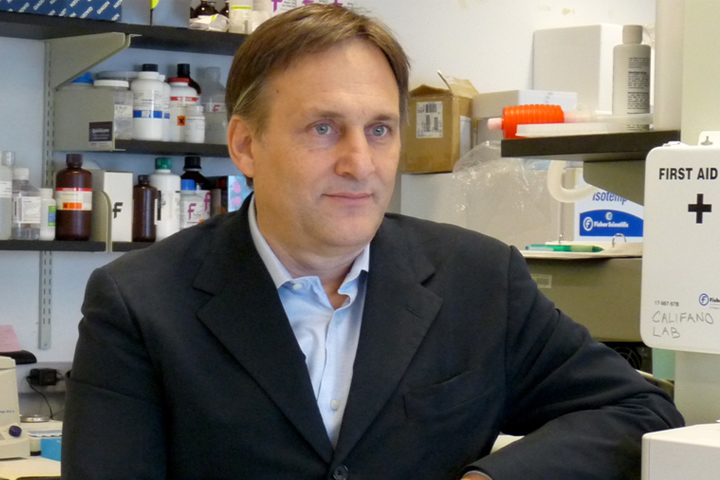Taking a Systems Biology Approach to Find a New Pancreatic Cancer Target

If you look at our basic biology, humans are big, cumbersome living organisms with a lot of moving parts.
For most of our lives, the cellular machinery that keeps us functioning goes off without a hitch. Starting at conception, cells have been growing and dividing, structuring themselves in a highly organized fashion. Liver cells know their job. And brain and spinal cord cells know their jobs, too.
Cancer is also a living organism. After all, it grows and evolves just like healthy cells. But cancer cells are cheats, ignoring the rules that other healthy cells play by. They mutate and divide uncontrollably, finding ways to evade our immune systems, which try to keep these invaders in check. To complicate matters, cancer cells are what scientists call heterogeneous. That means that even in the same malignant tumor there can be a variety of mutations, which is one reason why cancer treatment often fails. Drugs simply can’t target all of those mutations.
A branch of science called systems biology may help researchers home in on a better approach to cancer treatment by precisely targeting proteins called master regulators, instead of mutations. Among those leading the way in systems biology is Dr. Andrea Califano, the Clyde and Helen Wu Professor of Chemical and Systems Biology at Columbia University Irving Medical Center (New York); he also serves as Chair of the Department of Systems Biology, Herbert Irving Comprehensive Cancer Center, and Director of the JP Sulzberger Columbia Genome Center.
Using Systems Biology to Take Cancer Apart
Califano remembers when he first suggested that hypothesis. “Everybody talks about targeting genes that are mutated, especially in traditional biology and in precision medicine, but the master regulator proteins that we proposed as the true drivers of cancer cell state aren’t usually mutated in patients with cancer,” he says.
“I think it’s fair to say that some people were very doubtful, very skeptical, and I’m sure some still are. That is the nature of science. I’m a systems biologist and we look at things differently than traditional biologists. With systems biology we want to take cancer apart and see how it works, and the only way we can do that is by developing accurate computational models of how the cancer cell works. We call it model-based biology.”
It’s all very heady stuff and this unique approach is not surprising given Califano’s robust and varied scientific career. He began his career in Florence, Italy, where he worked as a theoretical physicist. He went on to the Massachusetts Institute of Technology (Cambridge) for post-doctoral study in computational physics and then joined IBM. There, he researched artificial intelligence and started the IBM Computational Biology Center. After leaving IBM he went on to develop his own experimental lab and company.
At Columbia, Califano and his diverse team of computational and experimental biologists use systems biology approaches to study cell regulatory networks. The hope is that dissecting and analyzing the complex regulatory networks that control human cell behavior will provide answers on how best to overcome the production and formation of tumors, drug resistance, and cellular heterogeneity.
“Cells can do all kinds of amazing things, and we now know that cancer is an extremely complex living organism,” he explains. “If you want to build an inventory of all the combinations of parts that may be broken in cancer—i.e., different patterns of mutated genes in different cancer cells—you’ll find that their number is larger than the number of atoms in the universe.”
He continues, “In systems biology, we want to take it (cancer) apart like a machine and look at how all the pulleys and gears work together. But we don’t look at one of them at a time or use brute force to look at every single gene or protein in isolation at a time like you would in traditional cancer genetics. We build models on how things work.
“We can then ask very complicated questions in a very simple manner. Biology has been largely an empirical science. In systems biology, we want to turn it into a quantitative, analytic science.”
Califano is a natural teacher, likening our cellular machinery, our master regulators, to an air conditioner. “When the room gets too hot or too cold, loops in the air conditioner signal for adjustment to get back to a stable temperature,” he explains. “It’s the same thing with master regulators. They act like sensors that prevent changes in the environment. So if a drug is delivered that would kill a cancer cell, the master regulators prevent the cancer cell from becoming unstable and easy to destroy. But the master regulators are also a target. They are a new class of tumor vulnerabilities.”
A New Target
In a 2018 article in the journal Nature Genetics, Califano and a team of researchers, including Dr. Irvin Modlin (professor emeritus with Yale University, now a consultant with Wren Laboratories LLC, Branford, Connecticut), along with collaborators from 17 research centers worldwide, detailed a proof of concept for an analytical platform applicable to any cancer type that shows what drug or drug combinations may be most effective in destroying those cancer cells based on the specific set of master regulator proteins that drive their tumors. The team looked specifically at a type of gastrointestinal cancer called gastroenteropancreatic neuroendocrine tumors (GEP-NETs), a rare cancer with a very low survival rate when it spreads.
In samples from 212 patients, the team targeted the master regulators for GEP-NETs. They then used the platform to predict which drugs could specifically stop the master regulators from doing their job. The team discovered multiple GEP-NET master regulators that linked progression from primary to metastatic disease. Despite the tumors being analyzed on an individual basis, the algorithm predicted the same top drug—Entinostat—for almost half of the metastatic patients. When the drug was tested in a xenograft transplant of the tumor in a mouse, the drug made tumors shrink, while drugs predicted to have partial or no effect were also validated to produce results in line with predictions. These data led to rapid Investigational New Drug approval by the FDA for a metastatic GEP-NET clinical trial that is open and recruiting patients at Columbia.
A Different Approach
The analytical platform is called OncoTreat, and it is available as a New York State Department of Health CLIA-approved test through the Department of Pathology and Cell Biology at Columbia for trials in GEP-NETs, breast, prostate, and other cancers, including pancreatic cancer.
In early work on pancreatic cancer tumor samples, OncoTreat identified at least one matching drug for more than 90 percent of patients. The Columbia team of Califano and Ken Olive, Ph.D., assistant professor of medicine and assistant professor of pathology and cell biology, was awarded a $2.2 million grant by the Lustgarten Foundation to support a clinical trial of the OncoTreat framework in pancreatic cancer patients as well as associated preclinical studies.
It’s clear that OncoTreat takes a different approach to what we know as precision medicine, which is simply developing treatment based on a person’s individual tumor. While most precision medicine efforts target mutations, only a few genetic drivers have been identified in pancreatic cancer. Even the most common driver, called KRAS, is tough to target. OncoTreat doesn’t target genetic mutations. “Only maybe 15 or 20 percent of pancreas cancer patients may benefit from treatment that’s traditional, like DNA mutation-based approaches in precision medicine,” Califano says. “It’s clear that in pancreas cancers as well as other cancers you need to find other targets.”
To find those master regulator targets, OncoTreat relies on sophisticated model-based biology that uses complex data science techniques spanning the range from information theory to algorithms like Viper technology that allows the researchers to navigate backward through the gene regulatory networks to identify the specific proteins that physically control the molecular signature of an individual patient’s tumor.
“I’m very excited by this because there’s a huge motivation in trying to make a difference in cancer,” Califano explains. “Cancer is a complex disease and to solve it we can’t hide behind simple solutions like you have this mutation, you use this drug. Most drugs targeting mutations don’t work a long time and treatment inevitably collapses. We had to think of a different way. Only time will tell whether this approach can make a difference.”
“Ten years ago I never imagined this as a potentially valuable tool (OncoTreat) for virtually every cancer. We certainly didn’t think it was predictive. All we had was a theory. Now we have a way forward.”





